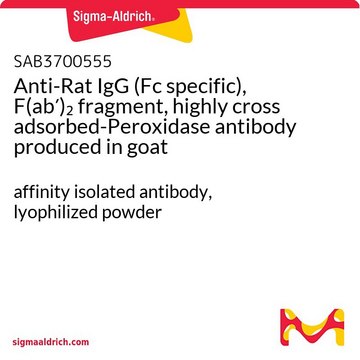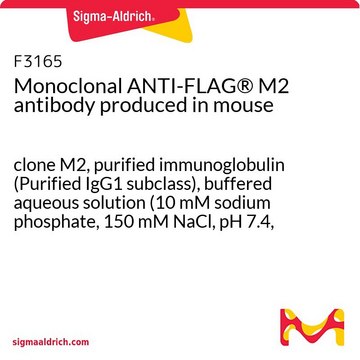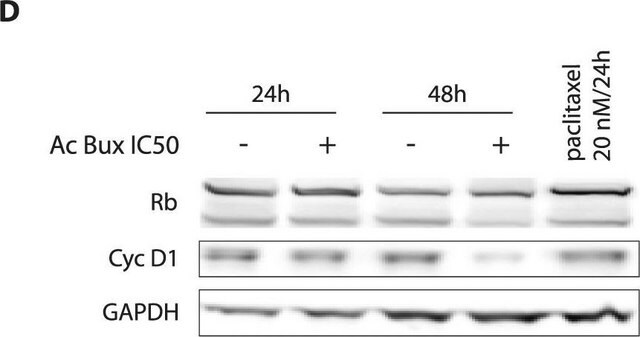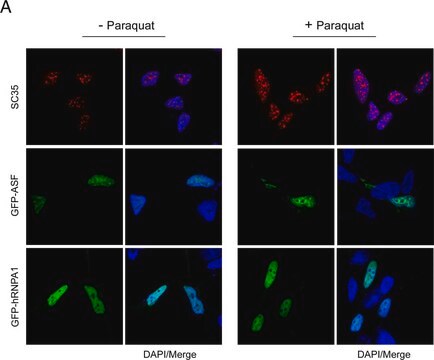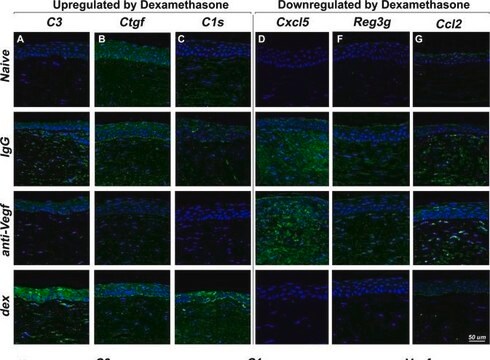推薦產品
生物源
mouse
品質等級
共軛
unconjugated
抗體表格
purified from hybridoma cell culture
抗體產品種類
primary antibodies
無性繁殖
1L4, monoclonal
形狀
buffered aqueous solution
分子量
antigen ~60 kDa
物種活性
human, rat, mouse
加強驗證
independent
Learn more about Antibody Enhanced Validation
濃度
~1.0 mg/mL
技術
indirect immunofluorescence: 5-10 μg/mL using Human HeLa cells.
western blot: 0.5-1 μg/mL using Whole extracts of mouse Hepa1-6 cells.
同型
IgG1
UniProt登錄號
運輸包裝
dry ice
儲存溫度
−20°C
目標翻譯後修改
unmodified
基因資訊
human ... PSPC1(55269)
mouse ... Pspc1(66645)
rat ... Pspc1(305910)
一般說明
Monoclonal Anti-PSPC1 (mouse IgG1 isotype) is derived from the hybridoma 1L4 produced by the fusion of mouse myeloma cells and splenocytes from BALB/c mice immunized with a synthetic peptide corresponding to a sequence at the C-terminal region of mouse PSPC1. DBHS (Drosophila behavior, human splicing) protein family, consisting also of NONO (nonPOU-domain-containing, octamer binding protein) and SFPQ (splicing factor, praline- and glutamine-rich). NONO, paraspeckle component 1 (PSPC1) and SFPQ are the core protein components of paraspeckles. These multi-functional nuclear proteins, under normal conditions, cycle between the nucleoplasm, paraspeckles and the nucleolus.
Paraspeckle component 1 (PSPC1) is encoded by the gene mapped to human chromosome 13q12.11. The encoded protein is a member of DBHS (Drosophila Behavior Human Splicing) family of proteins.
免疫原
Synthetic peptide corresponding to a sequence at the C-terminal region of mouse PSPC1, conjugated to KLH. 1 The corresponding sequence is identical in rat and human PSPC1.
應用
Monoclonal Anti-PSPC1 antibody produced in mouse has been used in immunohistochemistry, immunoblotting and immunofluorescence.
生化/生理作用
Drosophila behavior, human splicing (DBHS) proteins bind both double- and single-stranded DNA and RNA, and are involved in various aspects of RNA and DNA metabolism, such as transcription, pre-mRNA 3′ processing, transcription termination and mRNA splicing. DBHS proteins regulate circadian rhythm and carcinogenesis. PSPC1 activates androgen receptor mediated transcription. PSPC1 forms a heterodimer with NONO that localizes to paraspeckles in a RNA polymerase II-dependent manner.
Since paraspeckle component 1 (PSPC1) has lower background nucleoplasmic signal in various cell types compared to other members of DBHS (Drosophila Behavior Human Splicing) family of proteins, it is frequently used as a marker for paraspeckles. The encoded protein plays a vital role in regulation of transcription. Deletion of the gene is associated with the hindered psychomotor development, muscle hypotonia, unilateral microphthalmia with ptosis, congenital eye malformation and facial dysmorphic features.
外觀
0.01M 磷酸缓冲盐溶液,pH 7.4,含 15mM 叠氮化钠。
免責聲明
Unless otherwise stated in our catalog or other company documentation accompanying the product(s), our products are intended for research use only and are not to be used for any other purpose, which includes but is not limited to, unauthorized commercial uses, in vitro diagnostic uses, ex vivo or in vivo therapeutic uses or any type of consumption or application to humans or animals.
未找到適合的產品?
試用我們的產品選擇工具.
儲存類別代碼
12 - Non Combustible Liquids
水污染物質分類(WGK)
nwg
閃點(°F)
Not applicable
閃點(°C)
Not applicable
Structure of the heterodimer of human NONO and paraspeckle protein component 1 and analysis of its role in subnuclear body formation
Passon DM, et al.
Proceedings of the National Academy of Sciences of the USA, 109(13), 4846-4850 (2012)
First-trimester euploid miscarriages analysed by array-CGH.
Viaggi CD
Journal of applied genetics, 54, 353-359 (2013)
Neat1 in hematopoietic stem cells
Fallik N, et al.
Oncotarget, 8(65), 109575-109575 (2017)
Noam Fallik et al.
Oncotarget, 8(65), 109575-109586 (2018-01-10)
Hematopoietic Stem Cells (HSCs) generate blood and immune cells through a hierarchical process of differentiation. Genes that regulate this process are of great interest for understanding normal and also malignant hematopoiesis. Surprisingly, however, very little is known about long-non-coding RNAs
Paraspeckles
Fox A H
Cold Spring Harbor Perspectives in Biology, 2 (2010)
我們的科學家團隊在所有研究領域都有豐富的經驗,包括生命科學、材料科學、化學合成、色譜、分析等.
聯絡技術服務
